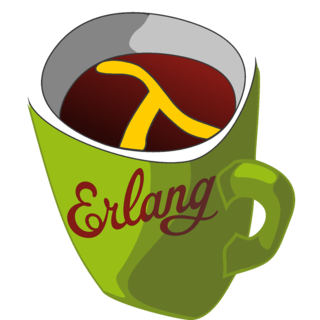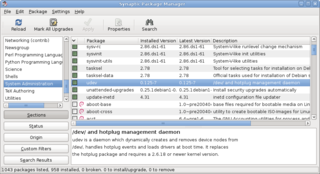
Dylan is a multi-paradigm programming language that includes support for functional and object-oriented programming (OOP), and is dynamic and reflective while providing a programming model designed to support generating efficient machine code, including fine-grained control over dynamic and static behaviors. It was created in the early 1990s by a group led by Apple Computer.

Emacs Lisp is a dialect of the Lisp programming language used as a scripting language by Emacs. It is used for implementing most of the editing functionality built into Emacs, the remainder being written in C, as is the Lisp interpreter. Emacs Lisp is also termed Elisp, although there is also an older, unrelated Lisp dialect with that name.

Lisp is a family of computer programming languages with a long history and a distinctive, fully parenthesized prefix notation.
Originally specified in 1958, Lisp is the second-oldest high-level programming language in widespread use today. Only Fortran is older, by one year. Lisp has changed since its early days, and many dialects have existed over its history. Today, the best known general-purpose Lisp dialects are Clojure, Common Lisp, and Scheme.
Scheme is a programming language that supports multiple paradigms, including functional and imperative programming. It is one of the three main dialects of Lisp, alongside Common Lisp and Clojure. Unlike Common Lisp, Scheme follows a minimalist design philosophy, specifying a small standard core with powerful tools for language extension.
MACLISP is a programming language, a dialect of the language Lisp. It originated at the Massachusetts Institute of Technology's (MIT) Project MAC in the late 1960s and was based on Lisp 1.5. Richard Greenblatt was the main developer of the original codebase for the PDP-6; Jon L. White was responsible for its later maintenance and development. The name Maclisp began being used in the early 1970s to distinguish it from other forks of PDP-6 Lisp, notably BBN Lisp.
In computer programming, the scope of a name binding – an association of a name to an entity, such as a variable – is the region of a computer program where the binding is valid: where the name can be used to refer to the entity. Such a region is referred to as a scope block. In other parts of the program the name may refer to a different entity, or to nothing at all.
In programming languages, a closure, also lexical closure or function closure, is a technique for implementing lexically scoped name binding in a language with first-class functions. Operationally, a closure is a record storing a function together with an environment. The environment is a mapping associating each free variable of the function with the value or reference to which the name was bound when the closure was created. Unlike a plain function, a closure allows the function to access those captured variables through the closure's copies of their values or references, even when the function is invoked outside their scope.
The Common Lisp Object System (CLOS) is the facility for object-oriented programming which is part of ANSI Common Lisp. CLOS is a powerful dynamic object system which differs radically from the OOP facilities found in more static languages such as C++ or Java. CLOS was inspired by earlier Lisp object systems such as MIT Flavors and CommonLoops, although it is more general than either. Originally proposed as an add-on, CLOS was adopted as part of the ANSI standard for Common Lisp and has been adapted into other Lisp dialects such as EuLisp or Emacs Lisp.
In computer programming, a generic function is a function defined for polymorphism.
Dynamic programming language, in computer science, is a class of high-level programming languages which, at runtime, execute many common programming behaviors that static programming languages perform during compilation. These behaviors could include extension of the program, by adding new code, by extending objects and definitions, or by modifying the type system. Although similar behaviours can be emulated in nearly any language, with varying degrees of difficulty, complexity and performance costs, dynamic languages provide direct tools to make use of them. Many of these features were first implemented as native features in the Lisp programming language.
Hygienic macros are macros whose expansion is guaranteed not to cause the accidental capture of identifiers. They are a feature of programming languages such as Scheme, Dylan and Rust. The general problem of accidental capture was well known within the Lisp community prior to the introduction of hygienic macros. Macro writers would use language features that would generate unique identifiers or use obfuscated identifiers in order to avoid the problem. Hygienic macros are a programmatic solution to the capture problem that is integrated into the macro expander itself. The term "hygiene" was coined in Kohlbecker et al.'s 1986 paper that introduced hygienic macro expansion, inspired by the terminology used in mathematics.
In computer science, a symbol table is a data structure used by a language translator such as a compiler or interpreter, where each identifier in a program's source code is associated with information relating to its declaration or appearance in the source. Symbol table stores the information related about the symbol.
Late binding, dynamic binding, or dynamic linkage is a computer programming mechanism in which the method being called upon an object or the function being called with arguments is looked up by name at runtime.
In computer science, a programming language is said to have first-class functions if it treats functions as first-class citizens. This means the language supports passing functions as arguments to other functions, returning them as the values from other functions, and assigning them to variables or storing them in data structures. Some programming language theorists require support for anonymous functions as well. In languages with first-class functions, the names of functions do not have any special status; they are treated like ordinary variables with a function type. The term was coined by Christopher Strachey in the context of "functions as first-class citizens" in the mid-1960s.

In computer science, the syntax of a computer language is the set of rules that defines the combinations of symbols that are considered to be a correctly structured document or fragment in that language. This applies both to programming languages, where the document represents source code, and markup languages, where the document represents data. The syntax of a language defines its surface form. Text-based computer languages are based on sequences of characters, while visual programming languages are based on the spatial layout and connections between symbols. Documents that are syntactically invalid are said to have a syntax error.

EuLisp is a statically and dynamically scoped Lisp dialect developed by a loose formation of industrial and academic Lisp users and developers from around Europe. The standardizers intended to create a new Lisp "less encumbered by the past", and not so minimalist as Scheme. Another objective was to integrate the object-oriented programming paradigm well. It is a third-generation programming language.
PC-LISP is an implementation of the Franz Lisp dialect by Peter Ashwood-Smith.
In computer programming, a variable or scalar is a storage location paired with an associated symbolic name, which contains some known or unknown quantity of information referred to as a value. The variable name is the usual way to reference the stored value, in addition to referring to the variable itself, depending on the context. This separation of name and content allows the name to be used independently of the exact information it represents. The identifier in computer source code can be bound to a value during run time, and the value of the variable may thus change during the course of program execution.

Lisp Flavored Erlang (LFE) is a functional, concurrent, garbage collected, Turing complete, general-purpose programming language and Lisp dialect built on Core Erlang and the Erlang virtual machine (BEAM). LFE builds on Erlang to provide a Lisp syntax for writing distributed, fault-tolerant, soft real-time, non-stop applications. LFE also extends Erlang to support metaprogramming with Lisp macros and an improved developer experience with a feature-rich read–eval–print loop (REPL). LFE is actively supported on all recent releases of Erlang; the oldest version of Erlang supported is R14.
In programming languages, name resolution refers to the resolution of the tokens within program expressions to the intended program components.





